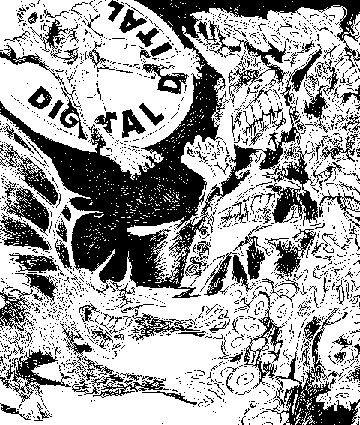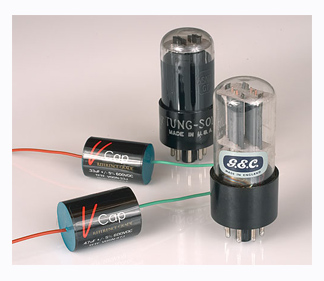|
You are reading the older HTML site
Positive Feedback ISSUE
19
Kennedy On Audio
Drawings by Bruce Walker Of Bits and Things Recently I started a job at a small firm that designs and manufactures a line of semiconductor ATE. In my new position I currently design analog front ends for instruments. One of the reasons I mention this is that it is interesting how many of the criteria important to good audio design also apply here. Component quality and design are crucial factors in getting good results, regardless of the end purpose. I sometimes worry that good analog design is becoming a lost art, or worse, that the skill set is being exported to foreign lands. You may wonder why this is a concern until you understand that digital quantization has limitations in dynamic range, resolution, and noise floor that are a concern both to audio and to electronic instrumentation. Careful choice of analog "helpers" ahead of an A/D for example can extend dynamic range, accuracy, noise performance, and make the best possible use of the limited number of bits available. Think, for example, of your typical 16-bit converter, which has 65,536 discrete amplitude steps, realize that the converter may be monotonic to only 14 bits, which is only 16,384 discrete steps, and then note that in a 16-bit converter for audio the Most Significant Bit (MSB) is actually the sign bit, so effectively you have 15 bits + sign. This doesn't sound like a big issue until you start to think about the sample rate. At a 44.1KHz sampling rate you have a new sample value every 22.67uS, which in theory forces the D/A to settle to 100% of this value in a fraction of this time. In addition, settling times should be the same for all code combinations, but in practice this is not usually achieved. Obviously, higher sampling rates and oversampling require better performance than this. Achieving good accuracy in an audio D/A converter is not trivial, and the I/V converter and reconstruction filter have exacting settling and linearity requirements that must be met for good performance. Perhaps it is not so surprising that early CD players did not sound too good; it is doubtful that they achieved anything like the required performance in the analog domain. Measured in terms of accuracy (say PPM), the typical audio circuit achieves relatively poor accuracy. Distortion percentages of 1% imply errors on the order of 10,000 PPM! Fortunately, the world of our senses is logarithmic, and it just so happens that errors in the range of 0.1dB – 1.0dB are not usually very perceptible, despite being equivalent to errors in the range of 1000ppm to 10,000ppm. Interesting… Definitely brings a new perspective to the concept of “accuracy” when audiophiles use this term. In absolute terms most audio equipment is not really accurate, but this may not be germane to good sound. Something to ponder I guess. Good Drives/Bad Drives One of the issues that have come to my attention lately is due to the fact that I own a much loved, but aging Lambda Drive, which still sounds terrific combined with my newly acquired Ultralink II, but which suffers from occasional hiccups due to issues with the long out of production Philips CDM9-PRO mechanism employed. Like many other older CD players and transports, there are virtually no spare parts/replacement parts or documentation for these units, and keeping this thing running is becoming extremely problematic. Sadly, I am faced with junking what was originally a several thousand dollar investment, and while nothing lasts for ever there is a huge difference between junking a $300 CD-67SE, for example, and a $2500 Lambda, which in this case probably still has seen less than 1000 hours of use. Someone less ethical would perhaps unload the drive on some unfortunate soul via one of the several extant online auction sites—and this is specifically what worries me. Any older drive made by any manufacturer at any time that contains a discontinued mechanism should be regarded with grave suspicion. Caveat Emptor! These things do wear out, and although my 15 year-old Sony still works fine and is in the hands of one of my friends, it cost a tiny fraction of what I paid for the Lambda drive. Frankly, you may be better off buying one of the many inexpensive new drives and CD players now showing up on eBay. Well respected brands are no guarantee either, particularly if the brand in question did not plan for the obsolescence of the mechanism in question. I should mention that PS Audio has been extremely supportive and provided all of the assistance they possibly could under the circumstances of their phoenix-like reincarnation. Their power stations are interesting indeed… Parts is not parts, OR The Amazing VCAP
I want to tell you about a wonderful new teflon/tin
foil coupling capacitor from VH Audio, the TFTF. Great sound and great
construction quality. I have been evaluating a few pairs of VCAPS for about 5
months now, and have spent more than 175 hours listening to them. These coupling
capacitors have brought a new level of resolution, openness and accuracy to my
system. They sound wonderful, do little to attract attention to themselves, but
are fundamentally truthful to the music. The level of low level detail is I have compared these to REL TFT, Jensen copper foil paper and oil types as well as the older RTX cap. My conclusion thus far is that the VCAP has better balance, greater detail, tighter bass and a much cleaner overall sound than the RTX, is much quicker sounding than the Jensen, but has the same warm/neutral midrange character I crave, and offers even more low level resolution than the TFT. The inner details of the music seem better revealed, sometimes for the first time. So far, I think these capacitors are the best I have ever heard, and do far less damage to the sound than most anything else I can think of. The break in period is claimed to be about 400 hours, with most of the benefit audible within the first 15-100 hours. In my case I would say that most of the improvement was audible within minutes of installing them, but they have continued to improve subtly over the additional hours I have listened to them. I recommend them, and will use them in all of my future designs. Coupling capacitors have as much, or maybe even a greater impact on the overall sound of a component as do interconnects, and it is hard to imagine a place where a few hundred dollars could make a larger improvement! You owe it to yourself to check them out at http://v-cap.com/tefloncapacitors.html. If you are one of those who don't believe that passive component quality truly makes a difference in the perceived sound quality of audio equipment, then I am probably talking to the hopelessly unconverted, or to someone who perhaps does not have equipment of sufficient resolution to tell the difference. In truth, other than a very few designs like the Citation I, which utilize fairly high levels of feedback (and also falls hands down in the resolution department due to excessive signal path complexity), I have never heard a tube component that did not benefit from judicious parts upgrades. Any DIY project by its nature is probably going to highlight the differences in components quality due to the generally simple and direct signal paths employed. I unhesitatingly recommend VCAPS for all of my designs, some of which you can find at: http://www.kta-hifi.net I plan to add some of my newer designs to the site in the coming months, and in the meantime there is plenty of information on older projects already there. Finding antique tubes and the like (All that glitters at fairer prices) I admit it, like some moth drawn to the flame I am inexorably drawn to the charm, linearity and overall good sound of vintage Directly Heated Triodes (DHT). Some months ago I purchased a boatload (should that be bloatload?!) of 30's, 31's, and 71A's, and even some IHT's like the venerable meshplate 27. I have some idea that some of these tubes may make it into a combined linestage/headphone amplifier. I acquired many of these new at an Antique Radio Show in Westford, Ma. , and at a price that is reasonable by the standards of what I see on eBay. Not everything good out there is limited to online venues like eBay. I encourage you to seek out the older timers at radio shows, because although most of them weren't born yesterday (literally), they often have a sense of fair play and propriety lacking in many of the online auctions. Their prices—while not always cheap—are a comparative bargain compared to the online world. Old Radio/TV shops are a disappearing breed here, but sometimes a little schmoozing will result in the secret stash being revealed, and offers to sell at considerable discounts may materialize quite suddenly. Take a look around your neighborhood; in fact ask your neighbors—I've gotten more than one good lead that way. Hamfests are another potential source, but most sellers of tubes/things audio have seen eBay, and you know what that means. Get there early, prospect carefully and you may find a bargain—they are still an excellent source of transformers, chokes, chassis, sockets, connectors, passives, tools and test equipment if not the tubes themselves. Most of all just have fun, take a friend! Perhaps one who is new to the game; show him/her your hifi. Spread the word. Until next time – happy tinkering!
|


 beyond
anything I have heard before, and they are now installed in all critical
locations in both the 26DHT pre-amplifier and the 300B SE amplifier I designed
and built in November. (This project will be featured in a future article here
at Positive Feedback Online.)
beyond
anything I have heard before, and they are now installed in all critical
locations in both the 26DHT pre-amplifier and the 300B SE amplifier I designed
and built in November. (This project will be featured in a future article here
at Positive Feedback Online.)